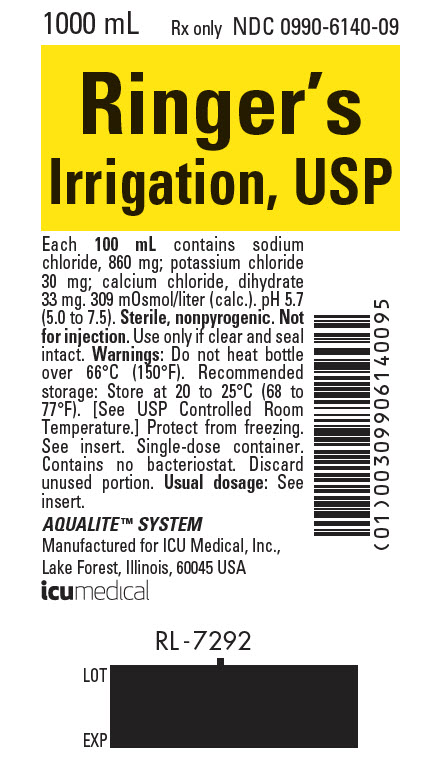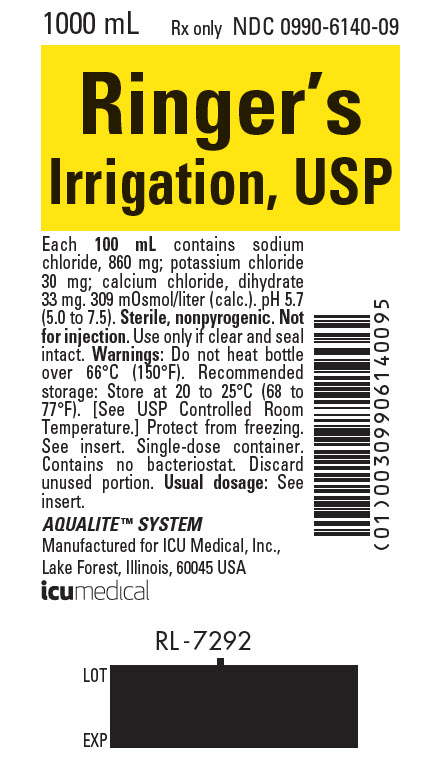Label: RINGERS IRRIGATION- sodium chloride, potassium chloride, and calcium chloride irrigant injection, solution
- NDC Code(s): 0990-6140-09
- Packager: ICU Medical Inc.
- Category: HUMAN PRESCRIPTION DRUG LABEL
- DEA Schedule: None
- Marketing Status: New Drug Application
Drug Label Information
Updated September 14, 2021
If you are a consumer or patient please visit this version.
- Download DRUG LABEL INFO: PDF XML
- Official Label (Printer Friendly)
- SPL UNCLASSIFIED SECTION
-
DESCRIPTION
These products are sterile, nonpyrogenic solutions of electrolytes in water for injection intended only for sterile irrigation, washing and rinsing purposes.
Each 100 mL of Ringer’s Irrigation, USP contains: Sodium chloride 860 mg; potassium chloride 30 mg; calcium chloride dihydrate 33 mg. The pH is 5.7 (5.0 — 7.5). The solution is isotonic (309 mOsmol/liter, calc.) and has the following electrolyte content (mEq/liter): Na+ 147.5; K+ 4; Ca++ 4.5; Cl− 156.
The solution contains no bacteriostat, antimicrobial agent or added buffer and is intended only for use as single-dose or short procedure irrigation. When smaller volumes are required the unused portion should be discarded. Ringer’s Irrigation, USP may be classified as a sterile irrigant, wash, rinse and pharmaceutical vehicle.
Calcium Chloride, USP is chemically designated calcium chloride dihydrate (CaCl2 • 2H2O), white fragments or granules freely soluble in water.
Potassium Chloride, USP is chemically designated KCl, a white granular powder freely soluble in water.
Sodium Chloride, USP is chemically designated NaCl, a white crystalline powder freely soluble in water.
Water for Injection, USP is chemically designated H2O.
The semi-rigid container is fabricated from a specially formulated polyolefin. It is a copolymer of ethylene and propylene. The container requires no vapor barrier to maintain the proper drug concentration.
Solutions in contact with the plastic container may leach out certain chemical components from the plastic in very small amounts; however, biological testing was supportive of the safety of the plastic container materials.
Exposure to temperatures above 25°C/77°F during transport and storage will lead to minor losses in moisture content. Higher temperatures lead to greater losses. It is unlikely that these minor losses will lead to clinically significant changes within the expiration period.
-
CLINICAL PHARMACOLOGY
Ringer’s Irrigation, USP exerts a mechanical cleansing action for sterile irrigation of body cavities, tissues or wounds, indwelling urethral catheters and surgical drainage tubes, and for washing, rinsing or soaking surgical dressings, instruments and laboratory specimens. It also serves as a vehicle for drugs used for irrigation or other pharmaceutical preparations.
Ringer’s Irrigation, USP provides an isotonic irrigation with the same ionic constituents as Ringer’s Injection, USP, a modification of Ringer’s solution (also called Ringer’s mixture) originally used only as a topical physiologic salt solution.
Ringer’s Irrigation, USP is considered generally compatible with living tissues and organs.
Calcium Chloride in water dissociates to provide calcium (Ca++) and chloride (Cl−) ions. They are normal constituents of the body fluids and are dependent on various physiologic mechanisms for maintenance of balance between intake and output. Approximately 80% of body calcium is excreted in the feces as insoluble salts; urinary excretion accounts for the remaining 20%.
Potassium chloride in water dissociates to provide potassium (K+) and chloride (Cl−) ions. Potassium is the chief cation of body cells (160 mEq/liter of intracellular water). It is found in low concentration in plasma and extracellular fluids (3.5 to 5.0 mEq/liter in a healthy adult). Potassium plays an important role in electrolyte balance.
Normally about 80 to 90% of the potassium intake is excreted in the urine; the remainder in the stools and to a small extent, in the perspiration. The kidney does not conserve potassium well so that during fasting or in patients on a potassium free diet, potassium loss from the body continues resulting in potassium depletion.
Sodium chloride in water dissociates to provide sodium (Na+) and chloride (Cl−) ions. Sodium (Na+) is the principal cation of the extracellular fluid and plays a large part in the therapy of fluid and electrolyte disturbances. Chloride (Cl−) has an integral role in buffering action when oxygen and carbon dioxide exchange occurs in the red blood cells. The distribution and excretion of sodium (Na+) and chloride (Cl−) are largely under the control of the kidney which maintains a balance between intake and output.
Water is an essential constituent of all body tissues and accounts for approximately 70% of total body weight. Average normal adult daily requirement ranges from two to three liters (1.0 to 1.5 liters each for insensible water loss by perspiration and urine production).
Water balance is maintained by various regulatory mechanisms. Water distribution depends primarily on the concentration of electrolytes in the body compartments and sodium (Na+) plays a major role in maintaining physiologic equilibrium.
- INDICATIONS AND USAGE
- CONTRAINDICATIONS
-
WARNINGS
FOR IRRIGATION ONLY. NOT FOR INJECTION.
Irrigating fluids have been demonstrated to enter the systemic circulation in relatively large volumes; thus this irrigation must be regarded as a systemic drug. Absorption of large amounts can cause fluid and/or solute overloading resulting in dilution of serum electrolyte concentrations, overhydration, congested states or pulmonary edema.
The risk of dilutional states is inversely proportional to the electrolyte concentrations of administered parenteral solutions. The risk of solute overload causing congested states with peripheral and pulmonary edema is directly proportional to the electrolyte concentrations of such solutions.
Do not heat over 66° C (150° F).
-
PRECAUTIONS
Do not use for irrigation that may result in absorption into the blood.
Caution should be observed when the solution is used for continuous irrigation or allowed to “dwell” inside body cavities because of possible absorption into the blood stream and the production of circulatory overload.
Aseptic technique is essential with the use of sterile solutions for irrigation of body cavities, wounds and urethral catheters or for wetting dressings that come in contact with body tissues.
When used as a “pour” irrigation, no part of the contents should be allowed to contact the surface below the outer protected thread area of the semi-rigid wide mouth container. When used for irrigation via irrigation equipment, the administration set should be attached promptly. Unused portions should be discarded and a fresh container of appropriate size used for the start-up of each cycle or repeat procedure. For repeated irrigations of urethral catheters, a separate container should be used for each patient.
Do not administer unless solution is clear, seal is intact and container is undamaged. Discard unused portion.
Drug Interactions
Additives may be incompatible. Consult with pharmacist, if available. When introducing additives, use aseptic technique, mix thoroughly and do not store.
Carcinogenesis, Mutagenesis, Impairment of Fertility:
Studies with Ringer’s Irrigation, USP have not been performed to evaluate carcinogenic potential, mutagenic potential, or effects on fertility.
Nursing Mothers:
Caution should be exercised when Ringer’s Irrigation, USP is administered to a nursing woman.
Pregnancy:
Teratogenic Effects.
Pregnancy Category C. Animal reproduction studies have not been conducted with Ringer’s Irrigation, USP. It is also not known whether Ringer’s Irrigation, USP can cause fetal harm when administered to a pregnant woman or can affect reproduction capacity. Ringer’s Irrigation, USP should be given to a pregnant woman only if clearly needed.
Geriatric Use:
Clinical studies of Ringer’s Irrigation have not been performed to determine whether patients over 65 years respond differently from younger subjects. Other reported clinical experience has not identified differences in responses between elderly and younger patients. In general, dose selection for an elderly patient should be cautious, reflecting the greater frequency of decreased hepatic, renal, or cardiac function, and of concomitant disease or other drug therapy.
This drug is known to be substantially excreted by the kidney, and the risk of toxic reactions to this drug may be greater in patients with impaired renal function. Because elderly patients are more likely to have decreased renal function, care should be taken in dose selection, and it may be useful to monitor renal function.
-
ADVERSE REACTIONS
Possible adverse effects arising from the irrigation of body cavities, tissues, or indwelling catheters and tubes are usually avoidable when proper procedures are followed. Displaced catheters or drainage tubes can lead to irrigation or infiltration of unintended structures or cavities. Excessive volume or pressure during irrigation of closed cavities may cause undue distention or disruption of tissues. Accidental contamination from careless technique may transmit infection. Should any adverse reaction occur, discontinue the irrigant, evaluate the patient, institute appropriate therapeutic countermeasures and save the remainder of the fluid for examination if deemed necessary.
- OVERDOSAGE
-
DOSAGE AND ADMINISTRATION
The dose is dependent upon the capacity or surface area of the structure to be irrigated and the nature of the procedure. When used as a vehicle for other drugs, the manufacturer’s recommendations should be followed.
Parenteral drug products should be inspected visually for particulate matter and discoloration prior to administration, whenever solution container permits. (See PRECAUTIONS.)
-
HOW SUPPLIED
Ringer’s Irrigation, USP is supplied in a single-dose 1000 mL semi-rigid irrigation container (NDC No. 0409–6140–09; NDC No. 0990-6140-09).
ICU Medical is transitioning NDC codes from the "0409" to a "0990" labeler code. Both NDC codes are expected to be in the market for a period of time.
Store at 20 to 25°C (68 to 77°F). [See USP Controlled Room Temperature.] Protect from freezing.
Revised: July, 2020
EN-5962
Manufactured for ICU Medical, Inc., Lake Forest, Illinois, 60045, USA
-
PRINCIPAL DISPLAY PANEL - 1000 mL Bottle Label
1000 mL
Rx only
NDC 0990-6140-09Ringer's
Irrigation, USP100 mL contains sodium
chloride, 860 mg; potassium chloride
30 mg; calcium chloride, dihydrate
33 mg. 309 mOsmol/liter (calc.). pH 5.7
(5.0 to 7.5). Sterile, nonpyrogenic. Not
for injection. Use only if clear and seal
intact. Warnings: Do not heat bottle
over 66°C (150°F). Recommended
storage: Store at 20 to 25°C (68 to
77°F). [See USP Controlled Room
Temperature.] Protect from freezing.
See insert. Single-dose container.
Contains no bacteriostat. Discard
unused portion. Usual dosage: See
insert.AQUALITE™ SYSTEM
Manufactured for ICU Medical, Inc.,
Lake Forest, Illinois, 60045 USA
icumedicalRL -7292
LOT
EXP
-
INGREDIENTS AND APPEARANCE
RINGERS IRRIGATION
sodium chloride, potassium chloride, and calcium chloride irrigant injection, solutionProduct Information Product Type HUMAN PRESCRIPTION DRUG Item Code (Source) NDC:0990-6140 Route of Administration IRRIGATION Active Ingredient/Active Moiety Ingredient Name Basis of Strength Strength SODIUM CHLORIDE (UNII: 451W47IQ8X) (SODIUM CATION - UNII:LYR4M0NH37, CHLORIDE ION - UNII:Q32ZN48698) SODIUM CHLORIDE 860 mg in 100 mL POTASSIUM CHLORIDE (UNII: 660YQ98I10) (POTASSIUM CATION - UNII:295O53K152, CHLORIDE ION - UNII:Q32ZN48698) POTASSIUM CHLORIDE 30 mg in 100 mL CALCIUM CHLORIDE (UNII: M4I0D6VV5M) (CALCIUM CATION - UNII:2M83C4R6ZB, CHLORIDE ION - UNII:Q32ZN48698) CALCIUM CHLORIDE 33 mg in 100 mL Inactive Ingredients Ingredient Name Strength WATER (UNII: 059QF0KO0R) Packaging # Item Code Package Description Marketing Start Date Marketing End Date 1 NDC:0990-6140-09 1000 mL in 1 BOTTLE; Type 0: Not a Combination Product 09/17/2021 Marketing Information Marketing Category Application Number or Monograph Citation Marketing Start Date Marketing End Date NDA NDA017635 09/17/2021 Labeler - ICU Medical Inc. (118380146) Establishment Name Address ID/FEI Business Operations Catalent Pharma Solutions, LLC 014167995 ANALYSIS(0990-6140)

